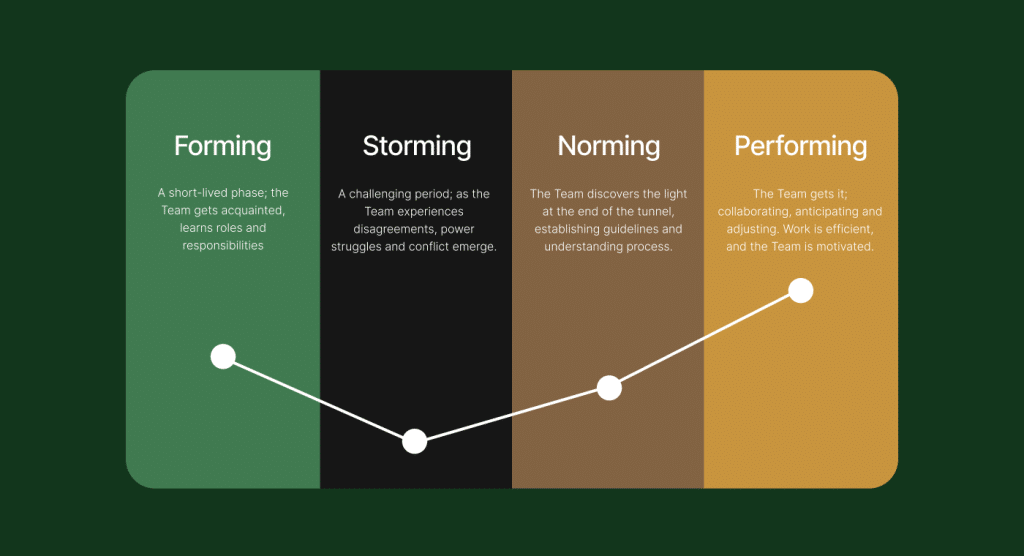
There are several concepts regarding team stages, one of the most popular ones are Tuckman’s model and ShuHaRi. They are well explained enough to be used for Agile. Our team commonly uses these Agile models in training and coaching, as well in articles as seen in today’s post. Despite its popularity, some argue that both models seem generic. It is seen more as a support for group development instead of a cross-functional and a self-organized team for Agile. In his first edition, Tuckman defined team stages with Forming, Storming, Norming and Performing. It’s a sequenced structure – meaning each stage has its own obstacle that needs to be overcome to be able to move the team to the next stage. (see Chapter 6 of Agile Y by H. Nguyen, 2016).
While Tuckman’s team model focuses on performance, ShuHaRi focuses more on the process. ShuHaRi is the team model of learning and practicing Agile. Respectively, Shu, Ha and Ri means following, branching, and owning. But Agile is an iterative and empirical approach for building a team and processing. While learning and practicing directly affects team performance.
The Agile coaches in our company prefer to combine the Tuckman model and ShuHaRi model: bringing the team through Tuckman’s model stages by supporting them to overcome their obstacles following the ShuHaRi model. It is based on the understanding of the team’s stage and its ShuHaRi needs in each stage.
Stage 1: The child (Forming, Storming) & Shu: Need a ‘manager’
In the beginning, the team is in chaos. A group of people in initial agreement of their vision and working method but a lot of disagreements on the process mechanism. During this time, a person who has strong management skills is needed. A manager who can bring a clear direction to the team can bring it out of its chaotic state. Right now the team is like a child, who does not question but only obeys. They need not to understand why red is the color for stop, they should just stop. Command and control is acceptable here by well explained reasons and high level of ‘command’: following code review and application of TDD.
Many people believe that an Agile team does not need leaders — that is utterly untrue. Any team has a leader in some way, with or without a title or stated responsibilities in the job description. There are two common reasons why Agile teams never step out of those stages. They either have a manager who lacks leadership spirit or a team leader who lacks management skills. A successful team needs both; a leader to set the direction and a manager who makes sure the team stays on course (the way of Shu). If these capabilities can be seen in one person (TeamLead or ScrumMaster), the team will experience clear communication during the Shu process that will majorly affect the Ha and Ri in the next steps.
Stage 2: The teenager (Norming) & Ha: Need a ‘leader’
At this point, teams should be in the organization stage, a half-team with their agreements that were built up from their experiences.
A team needs clear objectives and methodologies that reflect in their learning process. Like a teenager, the team now understands why red light is for stop and green light is for go. They also try to understand new things outside the two common options like yellow lights. A team needs a leader who supports their decisions to try various things in their own way, every little thing and every little step. A team may lack in knowledge and management skills but still needs a manager – even one who has beginner skills. The manager’s skills can be built up through leadership spirit.
Stage 3: The mature (Performing) & Ri: Need a ‘coach’
When the team reaches this stage, they should be self-organized and have enough skill sets to be able to perform well. A team needs a methodology to keep continuous improvement – a coach to keep them in check. Like an adult, the team understands why stoplights exist, when it should be red or when it should be green. The method and coach should be applied for the team and its members.
Understanding how your team works well is important to know. Their knowledge and skills are used to build up the team but the big steps should not be expected to happen during the child and teenager stages. In order to figure out whether to stay on course or step outside this stage, the team needs a deep understanding of the methodology rather than the practices. Every member of the team needs a coach to help figure out missing information or skills needed. They also manage the improvement process and give feedback.
FSNP-SHR
Leaders, managers, and coaches can easily see the model or pattern applied in a team. But the tricky part is recognizing the correct stage of the team. This is key to knowing when to correctly shift roles or responsibilities at the right time. These metrics are highly useful for the success of the project and continuous growth.
To see more of a teamwork style, check us out!




